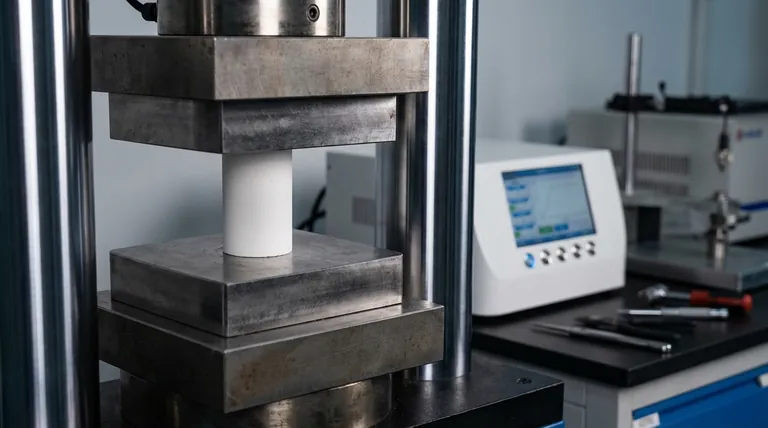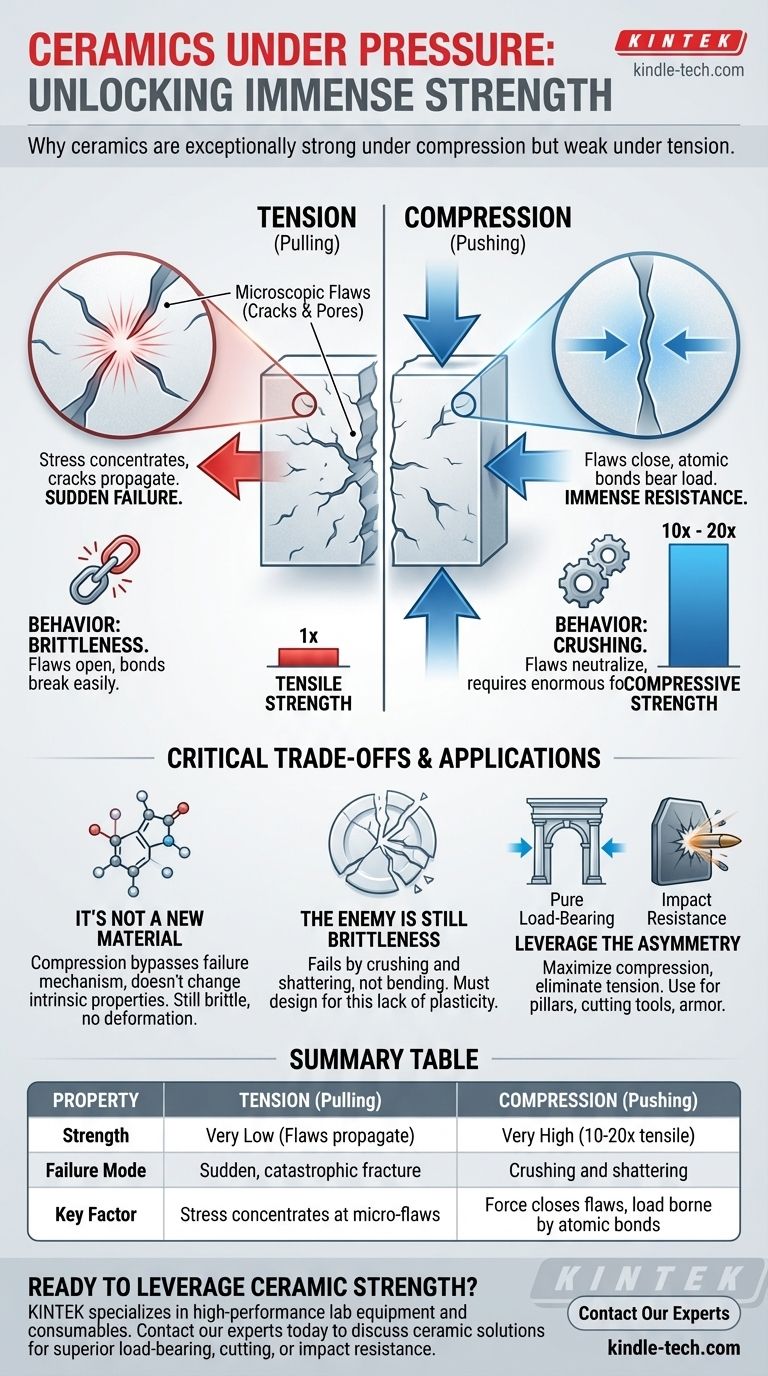네, 실질적인 의미에서 세라믹은 압력 하에서 예외적으로 강합니다. 이는 재료의 내부 특성이 변하기 때문이 아니라, 압축력이 세라믹을 부서지기 쉽게 만드는 미세한 결함을 무력화시키기 때문입니다. 세라믹을 압축할 때, 본질적으로 잡아당기는 힘에 의해 부서지게 만드는 작은 고유의 균열들을 닫는 것입니다.
세라믹의 엄청난 압축 강도는 재료 자체의 변화가 아닙니다. 오히려 압축 하중은 재료의 가장 큰 약점인 기존의 미세 결함을 효과적으로 비활성화시켜, 강력한 원자 결합이 하중을 직접 지탱할 수 있게 합니다.
압축과 인장이 세라믹에 있어 다른 이유
이러한 거동을 이해하려면 재료를 미시적인 수준에서 살펴봐야 합니다. 그 해답은 세라믹의 강력한 원자 구조와 피할 수 없는 미세한 불완전성 사이의 상호 작용에 있습니다.
세라믹의 구조
아무리 잘 제조된 세라믹 재료라도 미세한 결함을 포함하고 있습니다. 이는 작은 기공, 결정립계 또는 가공 또는 냉각 중에 도입된 미세한 균열일 수 있습니다.
세라믹 원자를 결합하는 이온 결합과 공유 결합은 엄청나게 강하지만, 이러한 결함은 약점의 지점 역할을 합니다.
인장 하에서의 거동 (당길 때)
세라믹을 당기면, 모든 인장 응력이 이러한 미세 결함의 날카로운 끝부분에 집중됩니다. 이 강렬한 집중은 작은 쐐기처럼 작용하여 원자 결합을 쉽게 벌립니다.
하나의 균열이 성장하거나, 즉 **전파(propagate)**되기 시작하고, 재료가 매우 단단하기 때문에 균열은 거의 즉시 전체 물체를 관통합니다. 이것이 세라믹이 인장 하에서 매우 적은 힘으로 갑자기 파국적으로 파손되는 이유이며, 우리는 이를 **취성(brittleness)**이라고 부릅니다.
압축 하에서의 거동 (밀 때)
세라믹을 밀면 정반대의 일이 일어납니다. 압축력은 이러한 미세 결함의 양쪽을 서로 밀착시켜 효과적으로 닫습니다.
이러한 약점이 무력화되면, 재료의 강도는 더 이상 결함에 의해 결정되지 않습니다. 대신, 하중은 전체 원자 구조와 강력한 화학 결합에 의해 지탱됩니다. 파괴는 힘이 너무 막대하여 이 구조를 으스러뜨릴 때만 발생하며, 이는 엄청난 양의 에너지를 필요로 합니다.

중요한 상충 관계 및 한계
압축 강도가 엄청난 이점이지만, 세라믹을 효과적으로 사용하려면 이 특성의 맥락과 한계를 이해하는 것이 중요합니다.
본질적으로 더 강해지는 것에 관한 것이 아님
압축 하의 세라믹은 새롭거나 개선된 재료가 아닙니다. 근본적인 특성은 변하지 않았습니다. 하중 방식—압축—은 단순히 주된 파괴 메커니즘을 우회할 뿐입니다.
만약 그 압축된 세라믹을 가져와서 약간의 인장력(예: 구부림)에 노출시킨다면, 여전히 특유의 낮은 인장 강도로 파손될 것입니다.
적은 여전히 취성
극심한 압축 하에서도 세라믹은 여전히 취성을 유지합니다. 금속처럼 파손되기 전에 구부러지거나 늘어나거나 변형되지 않습니다.
압축 한계에 도달하면, 부서지고 산산조각 나면서 파손됩니다. 이러한 **소성 변형(plastic deformation)**의 부족은 항상 고려해야 할 중요한 설계 제약 사항입니다.
두 가지 강도의 이야기
그 차이는 사소하지 않습니다. 일반적인 엔지니어링 세라믹의 **압축 강도**는 **인장 강도**보다 **10배에서 20배 더 클** 수 있습니다.
이러한 극적인 불균형은 이 재료로 설계할 때 이해해야 할 가장 중요한 기계적 특성입니다. 고대 로마의 아치나 현대의 콘크리트 댐이 매우 효과적으로 기능하는 이유가 바로 이것입니다. 이들은 세라믹 재료를 전적으로 압축 상태로 유지하도록 설계되었기 때문입니다.
응용 분야에서 세라믹 강도를 활용하는 방법
귀하의 설계 전략은 이 비대칭성을 기반으로 완전히 구축되어야 합니다. 목표는 항상 압축을 최대화하는 동시에 인장을 제거하는 것입니다.
- 순수한 하중 지지 능력이 주요 초점이라면: 세라믹은 지지 기둥, 절삭 공구, 방탄판과 같이 지배적인 힘이 압축력인 응용 분야에서 탁월한 성능을 제공합니다.
- 응용 분야에 굽힘이나 당김이 포함되는 경우: 다른 재료(예: 콘크리트의 철근)가 인장을 처리하는 복합 구조 내에서 세라믹을 사용하여 인장 응력으로부터 세라믹을 격리하도록 시스템을 설계해야 합니다.
- 내충격성이 목표인 경우: 세라믹은 파손을 통해 충격 에너지를 흡수한다는 점을 인식하십시오. 방탄복과 같은 응용 분야에서 이는 결함이 아니라 특징이며, 세라믹 판이 파손되어 투사체의 운동 에너지를 분산시킵니다.
압축 거동과 인장 거동 사이의 이러한 근본적인 차이를 이해하는 것이 세라믹 재료로 성공적으로 엔지니어링하는 열쇠입니다.
요약표:
| 특성 | 인장 하에서의 거동 (당길 때) | 압축 하에서의 거동 (밀 때) |
|---|---|---|
| 강도 | 매우 낮음 (결함이 균열을 전파시킴) | 매우 높음 (인장 강도의 10-20배) |
| 파손 모드 | 갑작스럽고 파국적인 파괴 | 으스러짐 및 산산조각 남 |
| 주요 요인 | 응력이 미세 결함에 집중됨 | 힘이 결함을 닫고, 하중은 원자 결합이 지탱함 |
귀하의 실험실 또는 제조 공정에서 세라믹의 엄청난 압축 강도를 활용할 준비가 되셨습니까? KINTEK은 최대의 내구성과 효율성을 위해 설계된 세라믹 부품을 포함하여 고성능 실험 장비 및 소모품을 전문으로 합니다. 당사의 전문 지식은 우수한 하중 지지, 절삭 또는 내충격성이 필요한 응용 분야에 적합한 재료를 확보하도록 보장합니다. 오늘 저희 전문가에게 연락하여 당사의 세라믹 솔루션이 프로젝트의 성능과 신뢰성을 어떻게 향상시킬 수 있는지 논의하십시오.
시각적 가이드

관련 제품
- 실험실용 이중 플레이트 가열 프레스 몰드
- 고압 적용을 위한 온간 등압 성형기 WIP 워크스테이션 300Mpa
- 버튼 배터리용 실험실 유압 프레스 랩 펠릿 프레스
- 액정 디스플레이 자동형 수직 압력 증기 멸균기 실험실 멸균기 오토클레이브
- 실험실 멸균기 랩 오토클레이브 펄스 진공 리프팅 멸균기



















